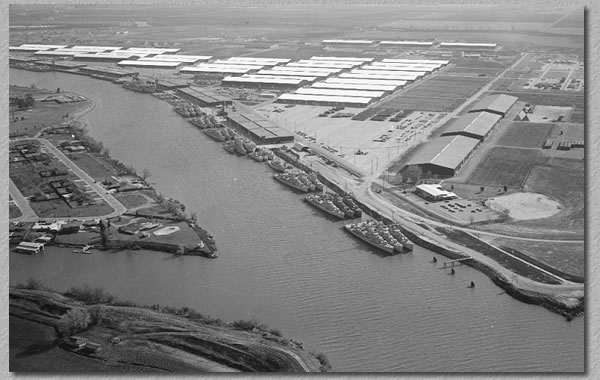
Pacific
Reserve Fleet, Rough & Ready Island, Stockton, CA (viewed from
the west)
[Photo
is copyright protected & provided courtesy of The Bank Of Stockton
Archives]
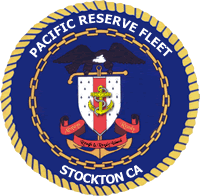
Pacific
Reserve Fleet
Stockton, CA
June 1962- June 1963

USS
Griffin, barracks ship . . . .
My
first orders out of boot camp, was to the Pacific Reserve Fleet
(mothball fleet) on Rough and Ready Island at Stockton, CA. I was
a little disappointed that I didn't receive orders to a sea going
greyhound, but what the hey, I was a real sailor now. We resided
in a decommissioned WWII vintage Submarine Tender (USS Griffin AS-13),
which was stuck in coffee grounds and mud, and pretty much welded
to the pier. This ship was so old that some of the heads (up forward)
still had the old continuous running water stainless steel troughs
under the toilet seats, instead of the more modern flush water closets.
You never took the first (farthest down hill) stall (or the second
stall, if you could help it), which was still downhill from the
other one or two. If you did, you left yourself wide open for someone
setting a wad of toilet paper on fire and letting it float down
the trough, right under your butt! If you have never literally felt
a fire under your butt, well let's just say it's a little startling!
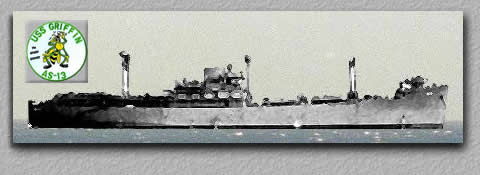
Paint,
paint, paint . . . .
Since
I didn't get a school coming out of boot camp, I spent about half
this tour on the deck force spray painting moth ball ships. We would
paint them all out in the traditional haze gray and deck gray (from
the waterline up), and then spray a preservative oil over our nice
cut-in paint job! While painting these ships, we would paint the
inboard side as fast as we could (since the old crusty boatswain
supervising us, just stayed stuck in his chair on the pier). By
the way, this crusty old boatswain (BM2) was the sole survivor of
a tin can during WWII - he was blown off the fantail when it was
sunk by a Japanese submarine. Then, before we tackled the outboard
side, we would break the seal (after someone showed us how to disconnect
the alarm first) and enter the ship. All the stuff was still sealed
inside the ship, including all the ship's logs. We found the deck
log and medical logs especially interesting to read, as many of
these ships (old Kaiser built tin cans) were in a lot of action
in WWII. Also, on occasion, while painting, we would accidentally
fall off the boatswain chair or raft into the water to cool off
- until they threaten to give us Tetanus shots if we continued.
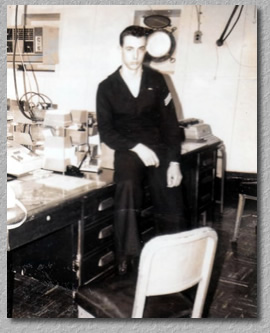
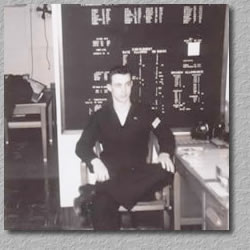
Top - Taken in First Division Office
(1962)
Bottom - Taken in
the Supply Office (1963), After Striking For Barber
Foggy
morning quarters . . . .
We
held our morning quarters out on the pier, weather permitting. In
the winter sometimes, the fog would roll in (fast and thick) before
they could secure us from quarters. Sometimes this fog would get
so thick that you couldn't see the guy next to you. It could be
real fun, at times, trying to find the brow in our quest to get
back on the ship!
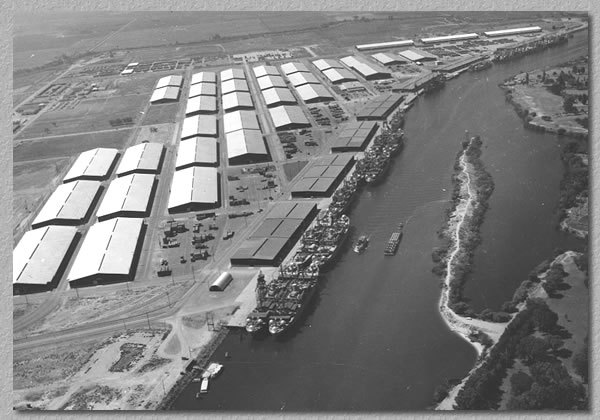
Looking from the east at the mothball
ships moored to the continuous
6500 ft long concrete pier along the Stockton Channel.
[Photo
is copyright protected & provided courtesy of The Bank Of Stockton
Archives]
The
Bos'n's hat . . . .
I remember making only $72 every
two weeks and I usually spent that on the first weekend. Of course,
if you were on board on the weekend (regardless if it was your normal
duty weekend), we were put on wash crews and spent one or both days
washing down the ships. Once, during one of these evolutions on
a very warm summer day, two of us wash teams (with fire hoses) were
chasing each other and wetting each other down (it was a very hot
day). Well, the Chief Bos'n CWO4 Carl was the CDO and decided to
check on us and we ended up catching him in a cross fire. Not only
did we drench him, we also blew his hat over the side. My $72 didn't
go very far the next pay day as we had to buy him a new hat.

A view along the Stockton Channel
showing Stephens Brothers Shipyards in the foreground, with Colberg
Boat Works just beyond. They built minesweepers for the Korean
War.
Liberty
card box . . . .
When
returning from liberty, early in the morning, you definitely wanted
to see the liberty card collection box at the head of the brow.
If you didn't, it meant that you were late because the box was removed
immediately upon expiration of liberty at 7am sharp. If you missed
the box, the division Chief would lose (or misplace) your liberty
card for about two weeks. For some reason, he just couldn't find
it. Fortunately, it never happened to me - being late that is, but
my liberty card did become lost or misplaced a couple times for
other minor discretions.
A
small problem with getting up at reveille . . . .
I
also had a problem, as many young sailors had, of not rising out of
my bunk at first call. Our Boatswain Mate First Class put an end to
that habit right off. He would come through our berthing compartment
a few minutes after reveille and wake everyone the first time. He
would return once again, about ten minutes later, and if you weren't
out of your bunk, he would cut the bunk lashings. Then, he would keep
you busy working until late in the evening before turning you loose.
You would then have to spend the rest of your evening hours relashing
your bunk, so you would have something to sleep in that night. I know,
it happened to me - and if you haven't ever had to relash your bunk,you're
fortunate as it it's not an easy task. I never slept in again and
to this day, I get right up whenever I'm awakened by someone and/or
an alarm.
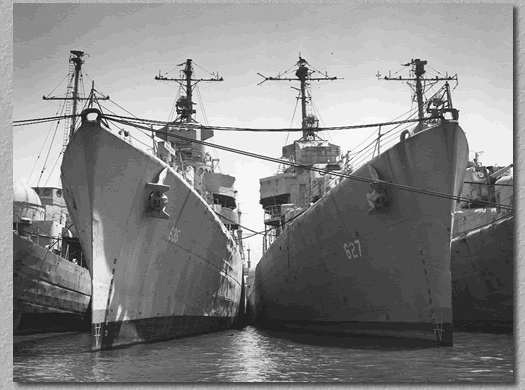
USS Earle DD-635 and USS Thompson
DD-627
[Photo
is copyright protected & provided courtesy of The Bank Of Stockton
Archives]
Duty
Driver incident . . . .
On
another occasion, while performing duty in the capacity of duty
driver late one night, I was a little bored and was attempting to
run down jack rabbits with the duty pick-up. The base had lots of
old warehouses and the base was infested with these wild rabbits.
Well, as I was going around one of these warehouses, in hot pursuit
of a rabbit, the Command Duty Officer was coming around in the opposite
direction. I damn near hit him head on! Well, needless to say, I
was relieved of my duty driver duties and delegated to pier sentry
duties for a couple months.
When I stood pier sentry watches, I had a
small transistor radio that I hid in my jacket and ran the ear phone
wires up inside my shirt. This way, I could flip the ear phone out
of my ear and down the inside of my shirt whenever the duty Chief
or CDO came around checking. I never did get caught listening to
the radio, which was a no-no because you were supposed to be listening
for alarms on the mothball ships.
On the towing crew . . . .
At times, the Navy would sell
a mothball ship for scrap or to a foreign country. On two of these
occasions, I volunteered as one of the crew members to ride the
ship from Stockton to Seattle, WA. They would have a 10-12 man skeleton
crew onboard while it was being towed by a sea going tug. The first
trip (an LSM, I believe - but I don't remember the name or number)
I volunteered for was my first official time at sea in the U. S.
Navy. So, being a "boot", I was the entertainment for
several old salts, like; "go fetch 5-fathoms of waterline",
or "go down to shaft alley and bring back the golden rivet".
I also was tasked to stand a 4-hr mail buoy watch. I really kept
a sharp lookout for that mail buoy too! They also tried their best
to get me seasick, but that didn't work as I don't get seasick -
I'm too clumsy, I guess.
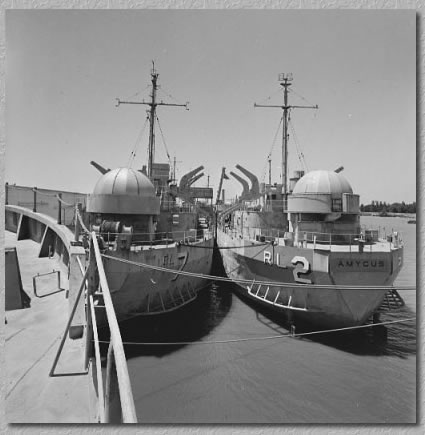
USS Atlas ARL-7 and USS Amycus ARL-2
- Both are converted LSTs
[Photo
is copyright protected & provided courtesy of The Bank Of Stockton
Archives]
Another towing crew story . . . .
On the second trip I volunteered
for, in September of 1962, we were onboard an old WWII Destroyer
Escort (USS Holt DE-706) which was to be overhauled in Seattle and
then loaned to the Republic of Korea. During this towing, we got
into a storm off the coast of Washington. I remember having the
tow watch (2000 to 2400) on the bridge - my job was to keep watch
on the status of the tow line from the sea going tug Tatnuck ATA-195.
This had been, up till this point, a pretty boring watch routine.
On this night the wind was blowing so hard that we were almost parallel
with the tug and the towline was almost directly perpendicular to
us. Early into the watch, after visually locating the tow line,
I heard "Twwaaaannngg"! The tow line had just parted and
all hell broke loose! We had no ship's power, so we were at the
mercy of the sea - and we took some tremendous rolls. I immediately
reported to the officer-in-charge that the tow line had parted.
We spent the next couple hours or so trying to get another line
over to the tug. The line would either fail to reach us or it would
part. A smaller Coast Guard Patrol Boat (an 82' boat) took over
from the tug and tried getting a tow line over to us, also with
no success. My hat is off to the crew of that Patrol Boat, they
stuck with us throughout the night. I say in this story that we
rolled around a lot, that Patrol Boat would completely disappear
at times because the waves were so high - they rolled around like
a cork in a bathtub. One of these lines, after parting, just barely
missed us and destroyed a metal gun tub shield behind us - I think
this where the Officer-In-Charge decided to send us inside as it
was getting too dangerous outside. It was difficult walking around
or even standing up at times, due to the ship rolls and bucking
around. In addition, we were soaking wet due to the waves washing
over the decks (and us). We had to continually keep tightening the
main mast guy-wires, due to its extreme whipping back and forth
- we were afraid that it may snap. The next morning, the Coast Guard
Cutter Wachusett WPG-44 finally got a good line over to us just
before we were about to run aground on Vancouver Island. Once that
was accomplished, the Cutter towed us into calmer waters in the
Strait Of Juan De Fuca where we then tied back onto the tug Tatnuck
and continued our journey to Seattle. Once, we were in calmer waters,
we surveyed any damage to the ship - especially from one collision
with the tug. I remember that we had put 25, 100lb blocks of ice
in the reefer, to keep our meat and perishables cold, prior to our
departure. Well, when we opened that reefer door, and looked in,
it looked like oatmeal mush! Being young, and somewhat foolish at
the time, I really didn't think much about how perilous the situation
really was. I just remember that just about all the old salts were
scared sh..less! Also, the headlines in the Seattle Post Intelligencer
read "Coast Guard Rescues Navy"! That was tough to live
down. But from that experience, to this day I have the utmost respect
for the Coast Guard. Through out my career, when telling this story,
I would relate the fact that (while I was on the bridge, just after
the tow line parted) I saw a roll approaching 60-degrees - it was
past 50 and heading to 60, on the gauge, before losing my balance.
A lot of guys would say "no way that ship could stay afloat
taking a roll that big!" Well, all I can say is that I specifically
remember that gauge's reading heading past 50-degrees and it was
still moving! I lost my balance and fell against the bulkhead so
I never saw the final reading. This wasn't the only roll like this,
we also took several more just like that.
I may have embellished this story somewhat, or
it may have become a more exaggerated in my mind over the years.
I just recently received an email from the Ops Officer (Dick G.
Taylor, LCDR, USCG Ret.) of the Coast Guard Cutter Wachusett (WPG-44)
with his observations the next day. This was the cutter that saved
our butt that day. He also included the official report from Bos'n
C.L. Carl, the officer in charge of the tow crew. The official report
is somewhat different than my recollection, but I swear we took
on water through a hole in the hull - I remember closing several
watertight hatches. I thought the portable diesel generator quit
soon after the line parted, but the official report states that
it stopped running much later. I also thought the tow line snapped
just as I relieved the watch, but the official report states the
line parted around 2100. Also, there was no mention of a parted
line crumpling that gun tub shield. Oh well, I guess that's what
old age does to ya - maybe I should have started the story with
"This is no bullsh**!"
You
can read the
Official Report
Here
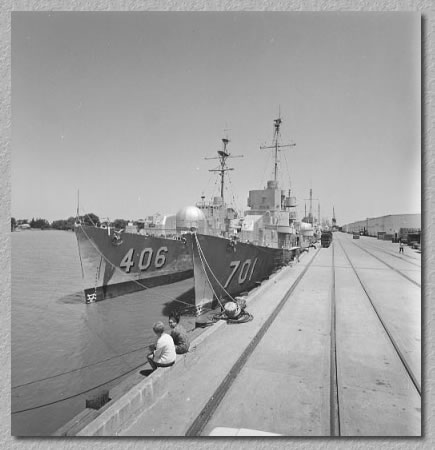
USS Edmonds DE-406 and USS Osmus
DE-701
[Photo
is copyright protected & provided courtesy of The Bank Of Stockton
Archives]
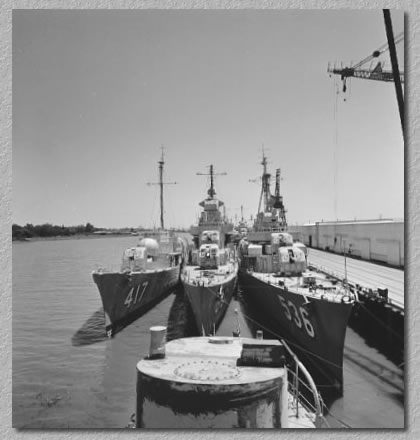
USS
Oliver Mitchel DE-417 (outboard), and USS Owen DD-536 (inboard)
[Photo
is copyright protected & provided courtesy of The Bank Of Stockton
Archives]
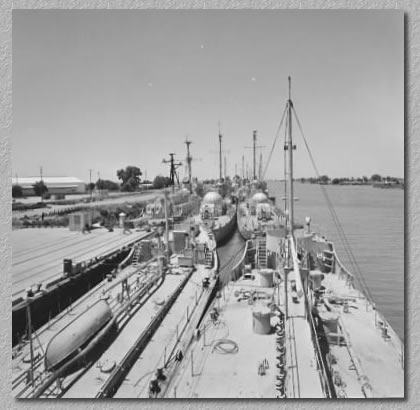
More Mothball Ships Along The Stockton Channel
[Photo is copyright protected & provided courtesy of The Bank
Of Stockton Archives]
Want
to strike for barber? . . . .
One
day I was compartment cleaning and someone stuck their head in the
door and said "does anyone in here want to strike for barber?"
I was the first one to the door! I was fed up with painting. In
fact, I still hate to paint anything to this day.
I
then spent the remainder of my tour learning to become a barber. I
was taught by an excellent barber, so I learned well. He had a tendency
to imbibe a little too heavy on occasion and forget where he parked
his car. The next day, we all had to help him find his car. I ran
into this gentleman again while I was on the L. Mendel Rivers in Charleston,
SC. He was a SHCM then, which surprised me as I never thought he would
ever get past SH2 - since he was busted so many times at Captain's
Masts.
Met
my wife . . . .
The
best thing that happened to me, while stationed here, was that I
met my wife - my true love, companion, and best friend for the past
40 years.
Ranks
Attained:
|

